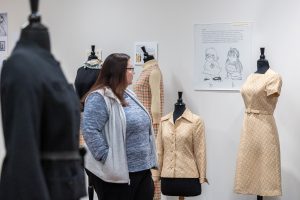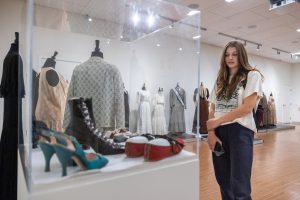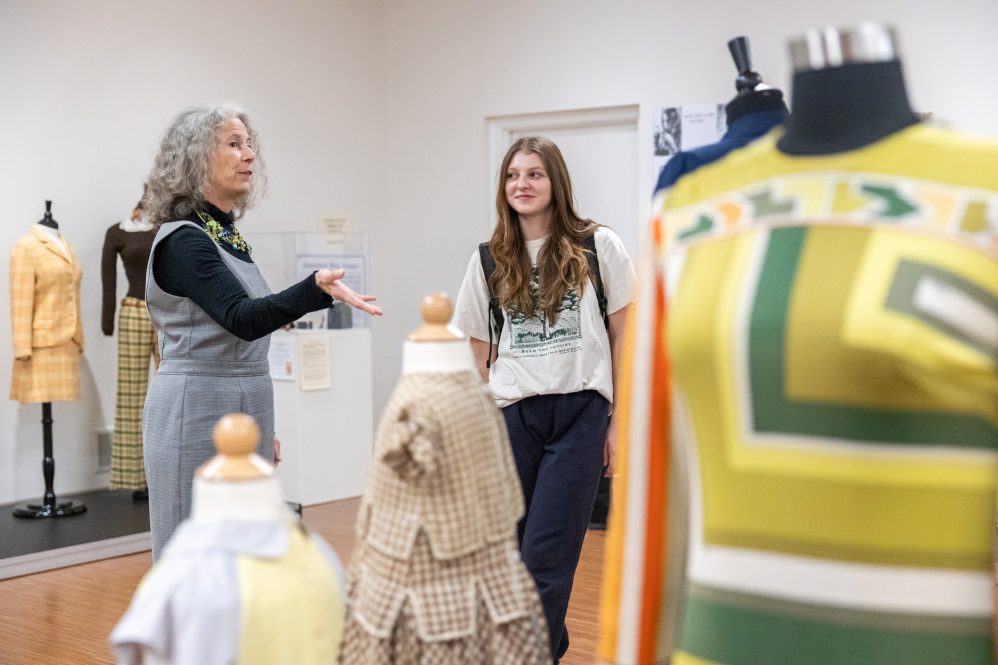What can we learn about women throughout history from the clothes they wear? At the Jorgensen Gallery, the latest exhibit showcasing women’s garments, accessories, and artifacts from a historic UConn costume collection prompts visitors to question their preconceptions about women’s history through fashion.
Located on the lower level of the Jorgensen Center for Performing Arts, the fittingly titled “Celebration! A New Chapter for the M. Estelle Sprague Collection” honors the 50th anniversary of the UConn Women’s Center. Running through Dec. 9, the exhibit traces the diverse and changing styles of women’s dress from the early 19th to 21st centuries.
“The nice thing about this collection is that there’s a little something for everybody,” says Exhibition Curator Susan J. Jerome.
Jerome notes that the artifacts on display are part of the larger M. Estelle Sprague Collection, which contains around 7,500 items including clothes, shoes, and other artifacts like letters and journals. This collection of mostly women’s clothes began informally in the 1920s, with donations from UConn faculty and staff to what was then the School of Home Economics. M. Estelle Sprague, a former dean of the School, became the collection’s namesake after her passing in 1940.

Recently, Jerome has led a larger effort to refine and arrange the collection for curation, with “Celebration!” being the result. As Director of Jorgensen Rodney Rock notes, this exhibit mirrors UConn’s history from its 1881 founding to the present.
“This fashion collection is a great way to give people a little insight into the types of women that were involved at the University during that whole period,” Rock says.
One of these women is Elizabeth May, another former dean of the School of Home Economics at UConn in the 1950s, whom Jerome says was “bucking gender roles” at a time when most administrators were men. Imitating their attire, May wore her own suits, two of which are on display: one 1950s gray designed by Adele Simpson and another 1950 navy Bonwit Teller. At the same time, Jerome points out their corseted style, “which emphasizes the shape underneath, but still looks very feminine.”
Jerome says one of her personal favorite pieces is a dress from about 1838, because it was donated by one of her close friends, Elizabeth Adam Noyes, who passed away last year. In addition to donating several garments to the collection, Noyes gave many paper artifacts, including letters and business records dating back to the late 1700s.
“We have garments, we have letters, we have so much information that can really tell us a lot about how people lived in the late 17 and early 1800s,” Jerome says.
While much can be gleaned from these records, Jerome notes the lack of information about those who respectively made, wore, and donated several of the collection’s other garments. More research is needed to obtain these details, which other UConn students, faculty, and staff may undertake, as the collection is also meant to serve as a resource for them.
“Celebration!” has already been insightful for the UConn graduate students studying costume design who helped with the exhibit’s installation. Jerome shares that these students usually only see pictures of objects like those on display.
“But to be able to look at the inside of a garment that was made in 1902 is very illuminating,” Jerome says. “You can see how the body is shaped under, and how the garment is meant to hang a certain way.”
In her own research, Jerome looked through several editions of UConn’s yearbook, The Nutmeg, which has been publishing annually since 1915. The exhibit includes images of pages from the 1975 yearbook, which had its own section written by women about women at the University for the first time.

Another image on display is from the 1965-66 Associated Women’s Student Handbook, which outlined the dress code for UConn’s women students. The excerpt lists the locations around campus where they were required to wear skirts.
“It certainly does show you the changes in values, expectations, and appropriateness in how society looks at women,” says Jerome.
Another major change that can be seen in the exhibit is the amount of skin women were able to expose over the years, with the most conservative garments dating from the 1800s. However, these early 19th century clothes have their own surprises. For example, one 1840s dress has a prominent pocket on the inside, which appears to be made from a large rock salt bag.
Discussing these early dresses, Jerome notes that many would be made at home or by a dressmaker, and are “one-of-a-kind.”
“When you make your own clothes, or you have a dressmaker make your own clothes, you’re the only one who’s wearing that. And that’s true for the 19th century,” Jerome says, adding it’s a practice “we’ve really lost.”
Jerome says this collection will ultimately go to The William Benton Museum of Art, where it will continue to support University programs.
Thinking about “Celebration!” as a whole, Jerome says it shows a “metamorphosis of women” from non-professional to professional working relationships in society.
“We’ve been around forever, we’re still here, and we’re still going forward,” Jerome says.



